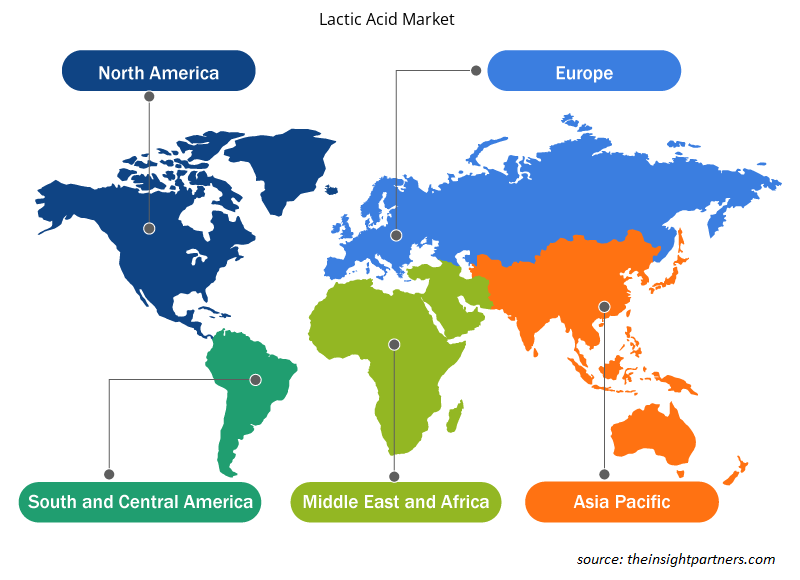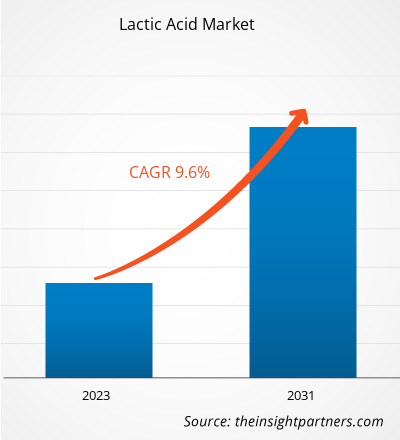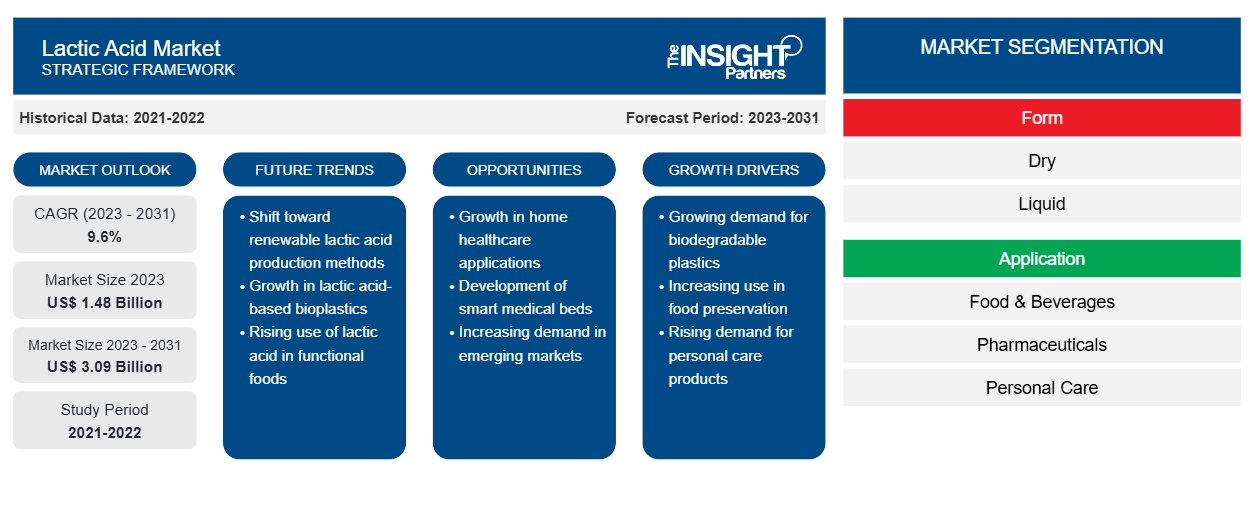Der Markt für Milchsäure soll von 1,48 Milliarden US-Dollar im Jahr 2023 auf 3,09 Milliarden US-Dollar im Jahr 2031 anwachsen. Der Markt wird voraussichtlich zwischen 2023 und 2031 eine durchschnittliche jährliche Wachstumsrate von 9,6 % verzeichnen. Wachsende Produktinnovationen und technologische Fortschritte werden voraussichtlich weiterhin die wichtigsten Trends auf dem Milchsäuremarkt bleiben.
Milchsäure-Marktanalyse
Milchsäure hat ein breites Anwendungsspektrum in verschiedenen Endverbrauchsbranchen, was das Marktwachstum von Milchsäure gefördert hat. Milchsäure, eine essentielle organische Säure, die von Milchsäurebakterien produziert wird, findet Anwendung in verschiedenen Branchen wie Lebensmittel und Getränke, Textilien, Körperpflege und Kosmetik sowie Pharmazeutika. Sie ist in mehreren Lebensmitteln natürlich vorhanden und wird in einer breiten Palette von Lebensmittelanwendungen verwendet, darunter Backwaren und Süßwaren, Milchprodukte, Fleischprodukte und Getränke. Milchsäure wird in der Milchindustrie auch zur Herstellung von Käse und Joghurt verwendet. Milchsäure wird in Lebensmitteln hauptsächlich als pH-Regler, Konservierungsmittel und Geschmacksstoff verwendet. Darüber hinaus wird Milchsäure zur Herstellung von Reinigungsprodukten, Shampoos, Feuchtigkeitscremes, Haarfärbemitteln und anderen Haut- und Haarpflegeprodukten in der Körperpflege- und Kosmetikindustrie verwendet. Milchsäure wird auch im Pharmasektor verwendet.
Marktübersicht für Milchsäure
Milchsäure ist eine organische Säure, die während des Fermentationsprozesses entsteht. Sie wird in verschiedenen Branchen verwendet, darunter Lebensmittel und Getränke, Pharmazeutika, Körperpflegemittel und biologisch abbaubare Polymere. Die Multifunktionalität der Milchsäure ermöglicht ihre Verwendung in verschiedenen Branchen. Die weltweit steigende Nachfrage nach verarbeiteten Lebensmitteln fördert die Anwendung von Milchsäure in der Lebensmittelindustrie. In Fleisch-, Geflügel- und Meeresfrüchteprodukten wird sie hauptsächlich als Entgiftungsmittel verwendet. In der Körperpflegeindustrie wird Milchsäure hauptsächlich in Anti-Aging- und Hautaufhellungsprodukten verwendet, da sie Hyperpigmentierung und Altersflecken behandelt.
Passen Sie diesen Bericht Ihren Anforderungen an
Sie erhalten kostenlos individuelle Anpassungen an jedem Bericht, einschließlich Teilen dieses Berichts oder einer Analyse auf Länderebene, eines Excel-Datenpakets sowie tolle Angebote und Rabatte für Start-ups und Universitäten.
-
Holen Sie sich die wichtigsten Markttrends aus diesem Bericht.Dieses KOSTENLOSE Beispiel umfasst eine Datenanalyse von Markttrends bis hin zu Schätzungen und Prognosen.
Treiber und Chancen des Milchsäuremarktes
Multifunktionalität von Milchsäure begünstigt den Markt
Milchsäure wird im Lebensmittel- und Getränkesektor üblicherweise synthetischen Chemikalien vorgezogen, da sie den Geschmack und die Textur von Produkten verändert und gleichzeitig ihre Haltbarkeit verlängert. Milchsäure wird in der Milchindustrie zur Herstellung von Käsearomen verwendet. Darüber hinaus fördert Milchsäure in der Brauindustrie die Stärkeumwandlung in Bier und erhöht so den Ertrag. In der Backindustrie hilft Milchsäure dabei, den Säuregehalt des Teigs zu kontrollieren und die Haltbarkeit von Backwaren zu verlängern. Darüber hinaus wird Milchsäure auch zur Herstellung von Emulgatoren wie Calcium- und Natriumstearoyllactylaten verwendet, die als Teigverbesserer fungieren. Die Multifunktionalität ist einer der Haupttreiber des weltweiten Marktanteils von Milchsäure.
Steigende Nachfrage nach biologisch abbaubaren Polymeren – eine Chance auf dem Milchsäuremarkt
Polymilchsäure (PLA) ist das Biopolymer mit dem größten Potenzial und das am häufigsten verwendete umweltfreundliche Polymer. Aufgrund seiner biologisch abbaubaren Eigenschaften findet Polymilchsäure eine breite Palette von Anwendungen in langfristigen und temporären implantierbaren Geräten, in der Gewebezüchtung, in Arzneimittelverabreichungssystemen und in verschiedenen anderen aufstrebenden Bereichen. Darüber hinaus wird es in jüngster Zeit auch in Lebensmittelprodukten, Verpackungsfolien und Flaschen mit kurzer Haltbarkeit verwendet. Da Polymilchsäure aus 100 % natürlichen Quellen gewonnen wird, hat sie in der Verpackungsindustrie zahlreiche Vorteile gegenüber petrochemischen Polymeren. Die Verwendung von Milchsäure in biologisch abbaubaren Polymeren nimmt erheblich zu, vor allem aufgrund des gestiegenen Bewusstseins der Verbraucher und der zunehmenden Verwendung biologisch abbaubarer Kunststoffverpackungen im Lebensmittelbereich. Daher wird erwartet, dass die steigende Nachfrage nach biologisch abbaubaren Polymeren einen positiven Einfluss auf den Milchsäuremarkt haben wird.
Segmentierungsanalyse des Milchsäuremarktberichts
Wichtige Segmente, die zur Ableitung der Milchsäuremarktanalyse beigetragen haben, sind Produkttyp, Kategorie und Endbenutzer.
- Basierend auf der Form ist der Milchsäuremarkt in trocken und flüssig unterteilt. Das Trockensegment hatte im Jahr 2023 einen größeren Marktanteil.
- Basierend auf der Anwendung ist der Milchsäuremarkt in Lebensmittel und Getränke, Pharmazeutika, Körperpflege und Sonstiges unterteilt. Das Segment Lebensmittel und Getränke hatte im Jahr 2023 einen größeren Marktanteil.
Milchsäure Marktanteilsanalyse nach Geografie
Der geografische Umfang des Milchsäuremarktberichts ist hauptsächlich in fünf Regionen unterteilt: Nordamerika, Asien-Pazifik, Europa, Naher Osten und Afrika sowie Südamerika/Süd- und Mittelamerika.
Der asiatisch-pazifische Raum hatte einen bedeutenden Anteil am Milchsäuremarkt. Die zunehmende Verwendung von Milchsäure in verschiedenen Anwendungen wie Lebensmitteln und Getränken, Pharmazeutika, Körperpflege und anderen hat zu einer steigenden Nachfrage nach Milchsäure geführt, was das Wachstum des Marktes im asiatisch-pazifischen Raum voraussichtlich ankurbeln wird. China, Indien und Japan sind die wichtigsten Märkte für Milchsäure in der Region. China ist der größte Exporteur und Hersteller von Milchsäure in der Region und der zweitgrößte Exporteur der Welt. Darüber hinaus weist der asiatisch-pazifische Raum eine hohe Konzentration von Unternehmen aus den Bereichen Lebensmittel und Getränke, Pharmazeutika und Körperpflege auf. In der Region sind auch Hersteller von Polymilchsäure wie Highchem Co Ltd, Musashino Chemical Laboratory Ltd, Corbion und NatureWorks LLC vertreten.
Regionale Einblicke in den Milchsäuremarkt
Die regionalen Trends und Faktoren, die den Milchsäuremarkt im Prognosezeitraum beeinflussen, wurden von den Analysten von Insight Partners ausführlich erläutert. In diesem Abschnitt werden auch die Marktsegmente und die Geografie des Milchsäuremarkts in Nordamerika, Europa, im asiatisch-pazifischen Raum, im Nahen Osten und Afrika sowie in Süd- und Mittelamerika erörtert.

- Holen Sie sich die regionalspezifischen Daten zum Milchsäuremarkt
Umfang des Marktberichts über Milchsäure
| Berichtsattribut | Details |
|---|---|
| Marktgröße im Jahr 2023 | 1,48 Milliarden US-Dollar |
| Marktgröße bis 2031 | 3,09 Milliarden US-Dollar |
| Globale CAGR (2023 - 2031) | 9,6 % |
| Historische Daten | 2021-2022 |
| Prognosezeitraum | 2023–2031 |
| Abgedeckte Segmente |
Nach Formular
|
| Abgedeckte Regionen und Länder |
Nordamerika
|
| Marktführer und wichtige Unternehmensprofile |
|
Dichte der Marktteilnehmer für Milchsäure: Deren Auswirkungen auf die Geschäftsdynamik verstehen
Der Markt für Milchsäure wächst rasant, angetrieben durch die steigende Nachfrage der Endverbraucher aufgrund von Faktoren wie sich entwickelnden Verbraucherpräferenzen, technologischen Fortschritten und einem größeren Bewusstsein für die Vorteile des Produkts. Mit steigender Nachfrage erweitern Unternehmen ihr Angebot, entwickeln Innovationen, um die Bedürfnisse der Verbraucher zu erfüllen, und nutzen neue Trends, was das Marktwachstum weiter ankurbelt.
Die Marktteilnehmerdichte bezieht sich auf die Verteilung von Firmen oder Unternehmen, die in einem bestimmten Markt oder einer bestimmten Branche tätig sind. Sie gibt an, wie viele Wettbewerber (Marktteilnehmer) in einem bestimmten Marktraum im Verhältnis zu seiner Größe oder seinem gesamten Marktwert präsent sind.
Die wichtigsten auf dem Milchsäuremarkt tätigen Unternehmen sind:
- Corbion
- Cargill Inc
- Foodchem International Corporation
- Galaktisch
- Henan Xinghan Biotechnologie
- Musashino Chemielabor Ltd.
Haftungsausschluss : Die oben aufgeführten Unternehmen sind nicht in einer bestimmten Reihenfolge aufgeführt.

- Überblick über die wichtigsten Akteure auf dem Milchsäuremarkt
Neuigkeiten und aktuelle Entwicklungen zum Milchsäuremarkt
Der Milchsäuremarkt wird durch die Erhebung qualitativer und quantitativer Daten nach Primär- und Sekundärforschung bewertet, die wichtige Unternehmensveröffentlichungen, Verbandsdaten und Datenbanken umfasst. Im Folgenden finden Sie eine Liste der Entwicklungen auf dem Markt für Innovationen, Geschäftserweiterungen und Strategien:
- Im August 2022 kündigten LG Chem und ADM zwei Joint Ventures zur US-Produktion von Milchsäure und Polymilchsäure an, um der wachsenden Nachfrage nach einer Vielzahl pflanzlicher Produkte, darunter Biokunststoffe, gerecht zu werden. Die angestrebte Jahresproduktion der beiden Joint Ventures betrug 150.000 Tonnen Milchsäure und 75.000 Tonnen Polymilchsäure. (Quelle: ADM, Pressemitteilung)
- Im März 2021 plante Corbion, die Milchsäurekapazität durch parallele Expansionsprojekte zu steigern. Diese Produktivitätsinitiativen werden die Versorgung der Kunden des Unternehmens in Europa und anderen Regionen mit Milchsäure, einem natürlichen Inhaltsstoff, erhöhen. (Quelle: Corbion, Pressemitteilung)
Marktbericht über Milchsäure – Umfang und Ergebnisse
Der Bericht „Marktgröße und Prognose für Milchsäure (2023–2031)“ bietet eine detaillierte Analyse des Marktes, die die folgenden Bereiche abdeckt:
- Marktgröße und Prognose auf globaler, regionaler und Länderebene für alle wichtigen Marktsegmente, die im Rahmen des Projekts abgedeckt sind
- Marktdynamik wie Treiber, Beschränkungen und wichtige Chancen
- Wichtige Zukunftstrends
- Detaillierte PEST/Porters Five Forces- und SWOT-Analyse
- Globale und regionale Marktanalyse mit wichtigen Markttrends, wichtigen Akteuren, Vorschriften und aktuellen Marktentwicklungen
- Branchenlandschaft und Wettbewerbsanalyse, einschließlich Marktkonzentration, Heatmap-Analyse, prominenten Akteuren und aktuellen Entwicklungen
- Detaillierte Firmenprofile
- Historische Analyse (2 Jahre), Basisjahr, Prognose (7 Jahre) mit CAGR
- PEST- und SWOT-Analyse
- Marktgröße Wert/Volumen – Global, Regional, Land
- Branchen- und Wettbewerbslandschaft
- Excel-Datensatz
Aktuelle Berichte
Verwandte Berichte
Erfahrungsberichte
Grund zum Kauf
- Fundierte Entscheidungsfindung
- Marktdynamik verstehen
- Wettbewerbsanalyse
- Kundeneinblicke
- Marktprognosen
- Risikominimierung
- Strategische Planung
- Investitionsbegründung
- Identifizierung neuer Märkte
- Verbesserung von Marketingstrategien
- Steigerung der Betriebseffizienz
- Anpassung an regulatorische Trends























 Kostenlose Probe anfordern für - Milchsäuremarkt
Kostenlose Probe anfordern für - Milchsäuremarkt